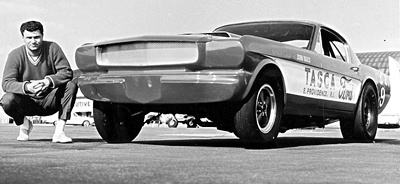| |
"We knew that NASCAR's main interest was always going to be stock car
racing," said Weis. "They had 150 people that worked one of their big
Grand National shows; we had just five at a drag race. I think the reason
they did this was that they didn't realize what it took to run a drag
race."
Xakellis concurred.
"I don't think NASCAR was ever overboard about drag racing," he said.
"Witzberger came to them with an idea, they looked over their facts
and figures, and let their drag racing program sink or swim with him.
NASCAR, quite simply, didn't know how to run a drag race, but they saw
a profit potential and certainly an increase in exposure for themselves.
The other thing that was important was that NASCAR drag racing was an
East Coast phenomenon. NHRA and AHRA were all over the country; it just
so happened that in 1966, NHRA wasn't as developed as it was in say,
California or the Midwest."
The 1966 season began in Florida and veteran Wilmington, Del. racer
Joe Jacono grabbed the No. 1 Fuel title aboard the Cassidy & Winward/"Brief
Encounter" dragster. In the final, Jacono logged an 8.08/187.50 to beat
Val LaPorte's 8.08/191.08 in his "All-American", the former Norm Weekly-driven
Orange County Metal Processing Top Fuel dragster. LaPorte had low e.t.
and top speed with a 7.92/196 shot.
 In
the Grand Stock competition, Bill Lawton drove the Tasca Ford '66 Mustang
(right) to the Heads Up eliminator title, and Tommy Grove (photo below)
wheeled his '66 Mustang to the Handicap Eliminator title. (Heads Up was
made up of the eight lowest e.t.s by door cars regardless of class, while
Handicap consisted of the finalists in each class of Ultra Stock - AFXers,
B/FXers, and Gas Funny Cars) run against the class record. In
the Grand Stock competition, Bill Lawton drove the Tasca Ford '66 Mustang
(right) to the Heads Up eliminator title, and Tommy Grove (photo below)
wheeled his '66 Mustang to the Handicap Eliminator title. (Heads Up was
made up of the eight lowest e.t.s by door cars regardless of class, while
Handicap consisted of the finalists in each class of Ultra Stock - AFXers,
B/FXers, and Gas Funny Cars) run against the class record.
 |
| Photo by Chester Kirk |
The south is stock car country and the NASCAR show featured the best cars
on the East Coast. Lawton, of course, won Stock at the 1965 NHRA Winternationals,
and Grove was also a past Winternationals Stock champ. In the field were
Bud Faubel's "Honker," Phil Bonner (below), Al Eckstrand's "Lawman," Dave
Strickler, and future NHRA Winternationals Super Stock champ Al Joniec.
.
The fuel field wasn't as strong. Jacono and LaPorte had to fight their
way past ultra-trivial competition like Florida racers Wayne Miller
and Chuck Rearick's Chevy-powered fuel dragsters, and the Chrysler fuelers
of St. John's, Michigan's Bob Gladstone and Niles, Ill.'s Rick Wakefield.
Not much to write home about, but the fuel shows would improve nationally
and, of course, on the circuit.
The first fuel circuit event was held May 1 at Weis' Richmond Dragway
and that didn't get off too much of a start, although it wasn't due
to lack of competition; that element improved. The show came to an unceremonious
close when it rained after qualifying. At that point, Jacono led qualifying
with an 8.13, just .07 off Connie Kalitta's track mark, and right behind
him on the qualifying list were then NASCAR fuel record holder (7.56)
Ray Marsh, George Van in the Czerniak & Van "Goldfinger" dragster, and
Fred Forkner's "Quarter Horse."
The first Grand Stock circuit show unfolded the next day at nearby
Suffolk Raceway and all the stars (or most of them seen at Deland) were
in attendance. Vernon Rowley drove the Buckeye & Vernon (ex-Sox & Martin/Gate
City Motor Co.) '65 Plymouth to the heads up title over Tom Sneden's
"Bounty Hunters" Dodge, and Glen Frazier's "Black Jack" Ford Fairlane
won the Handicap title over Melvin Yow's Dodge.
|